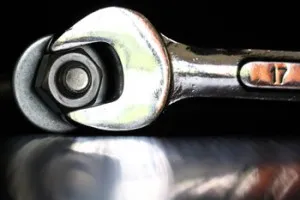The cold winter months are behind us and summer is quickly approaching. So the time is just right to start on some garage door maintenance.
Winter’s icy conditions and cold weather can be tough on garage doors, so some repairs and touch ups may be needed. And the inside of the garage will need some maintenance done as well.
You may think your garage door and door opener look fine. But checking the parts, cleaning and repairing any damage can save you a lot of money later on. Here are some general tips to keep your garage door in top shape for the summer months.

1. Clean the Door
Garages aren’t exactly the cleanest areas of a home. It’s usually where you store your car, tools, boxes or supplies, which can collect dust, dirt and grease. And that’s just the inside!
The part of the door that is exposed to the elements will be filthy as well. You will want to wash the garage door, both the inside facing part and the outside. To prevent dust build-up, you can add a thin layer of car wax to both sides of the door.
With garage doors that are made out of wood, you may find that rotting can be an issue. You may want to consider adding a fresh coat of paint and apply a water sealant on both sides of the door to prevent rot from occurring. If the rot spreads, you may need to replace the garage door entirely. If you have a steel door, check it for rust. Any rust you find can be sanded down and painted over with a zinc primer.
2. Lubrication
Lubricate all moving parts (rollers, tracks, hinges) and the weather stripping, as well as the garage door opener’s track. This is important to keep your garage door operating correctly and will help prevent any damage.
Avoid using oils like WD-40. Use lubricant oil that is specifically used for garage door use. Also, avoid using too much oil. Laying a thick layer of oil on will accumulate dust and dirt, which can wear out the parts. For exterior weather stripping, use a lubricant with silicone.
3. Check for Wear and Tear
First, check the cables to the garage door. Are they frayed or do they look worn? If so, you will want to replace them immediately by contacting a local garage door company. Replacing the cables yourself could be a dangerous job if you don’t know what you are doing.
You will also want to make sure the hinges, ball-bearings, rods and supports are in good shape as well. If you spot any damage or if anything is loose, you will need to fix the issue so you won’t have to deal with a hefty repair bill later on.
4. Check the Bolts
Check the bolts at the back of the track and make sure none of them are loose. Not only is this a maintenance concern, but it’s important for safety as well. The last thing you need is for the garage door to fall and damage your car or injure someone.
5. Check the Springs
The garage door springs should be rust free. Springs can and will break, no matter how well you take care of them, but keeping them rust free will prolong their life.
If a spring does break, it can launch across the garage due to the high tension. Some garage doors have their springs contained in a tube. You won’t have to worry about any maintenance with these. If you do have a broken spring, or if you need to replace one, don’t do it yourself. Call in a professional garage door expert to do the job for you.
Lastly, you can check the tension of the springs by pulling the emergency release on the door while it is closed. After you pulled the release, lift the door to waist height. If the door closes, the springs need more tension. If the door flies open, the springs need less tension. Your goal is to have the door stay open at waist height.
6. Weather Stripping and Insulation
Clean and replace any damaged weather stripping (bottom section and at the perimeter) and insulation.
Weather stripping and insulation help keep the garage dry. It also prevents the hot or cold air from coming in and damaging any items in your garage.

Add new comment